View in other NatureServe Network Field Guides
NatureServe
Montana
Utah
Wyoming
Idaho
Wisconsin
British Columbia
South Carolina
Yukon
California
New York
Spring White - Pontia sisymbrii
Native Species
Global Rank:
G5
State Rank:
S5
Agency Status
USFWS:
USFS:
BLM:
External Links
General Description
[From Ferris and Brown 1981; Scott 1986; Opler and Wright 1999; Glassberg 2001; Pyle 2002] Forewing 1.8-2.3 cm. Base color white (males) or pale yellow (females), wings more translucent than close relatives. Uppersurface with narrow and centrally-notched black bar in forewing cell, forewing with a series of postmedian and marginal black marks along veins at wing tip. Undersurface of hindwing with pattern of brownish-black scaling along veins, some yellow scales directly on veins, with a postmedian whitish interruption.
Phenology
One flight, February to March in southern deserts, April to May in Colorado, mid-May to June in Canada (Scott 1986). One flight, February to April in southwestern deserts, April to June in Oregon, British Columbia, Colorado, South Dakota, into August at high elevations (Glassberg 2001). March to early June in Rocky Mountain states (Ferris and Brown 1981), late March to mid-June in Colorado (Scott and Scott 1978; Scott and Epstein 1987), late June to mid-July at high elevation in northern California (Shapiro 1977), late March to late August in Oregon and Washington (Pyle 2002), late March to early August in Oregon (Warren 2005), April to early July in British Columbia (Guppy and Shepard 2001).
Diagnostic Characteristics
Best determined by a combination of whitish base color, uppersurface of forewing with narrow and centrally-notched black cell bar, forewing with a series of postmedian and marginal black marks along veins at wing tip, undersurface of hindwing with brownish-black scaling along veins, some yellow scales directly on veins, with a postmedian whitish interruption.
Species Range
Montana Range
Range Descriptions
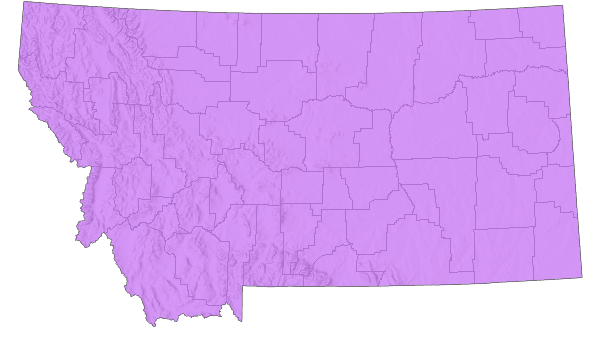
 Native
Native
Range Comments
Southern Yukon and western Northwest Territories south through low and mid-elevation mountains to central Baja California and northwestern Mexico, east to western South Dakota, Nebraska, western Oklahoma, western Texas (Scott 1986; Opler and Wright 1999; Glassberg 2001); normally below 2591 m elevation in the Rocky Mountain states (Ferris and Brown 1981), 1585 m to 2621 m elevation in Colorado (Brown 1957; Scott and Scott 1978), to about 2743 m elevation in northern California (Shapiro 1977), 183 m to at least 2438 m elevation in Oregon (Warren 2005). In Montana, reported from at least 30 counties across the state, but less often in the eastern 1/2 (Kohler 1980; Stanford and Opler 1993; FLMNH Lepidopterists' Society database), 875 m to at least 1661 m elevation, with a report from Carbon County of 3042 m elevation. Uncommon to abundant (Glassberg 2001).
Observations in Montana Natural Heritage Program Database
Number of Observations: 19
(Click on the following maps and charts to see full sized version)
Map Help and Descriptions
Relative Density
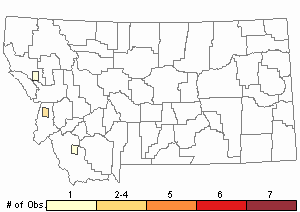
Recency
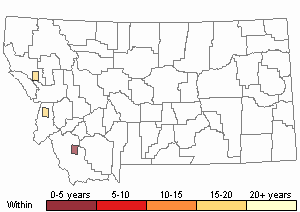
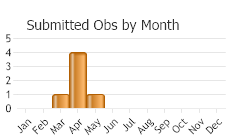
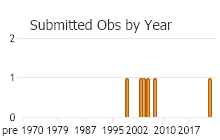
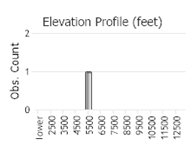 (Observations spanning multiple months or years are excluded from time charts)
(Observations spanning multiple months or years are excluded from time charts)
Migration
Non-migratory.
Habitat
Lower-elevation canyons, riparian canyons in arid areas, desert hills, dry rocky areas, chaparral, sagebrush, pine forest, roadsides, above treeline in dry rocky alpine terrain (Ferris and Brown 1981; Scott 1986; Opler and Wright 1999; Glassberg 2001; Pyle 2002; Warren 2005; James and Nunnallee 2011). In Greater Yellowstone Ecosystem, reported from open coniferous forest, rocky outcrops, canyons, rocky desert, alpine slopes (Debinski and Pritchard 2002).
Food Habits
Larval food plants are native and exotic mustards, including Arabis (multiple species), Caulanthus, Descurainia, Sisymbrium, and Streptanthus (several species) (Emmel et al. 1970; Ferris and Brown 1981; Scott 1986, 1992, 2006; Pyle 2002; Graves and Shapiro 2003; Warren 2005; James and Nunnallee 2011). Adults feed on flower nectar (including Arabis, Cerastium, Claytonia, Collinsia, Lathyrus, Lesquerella, Lomatium, Thlaspi, Viola) and mud (Scott 2014).
Reproductive Characteristics
Females lay eggs singly anywhere on host plant (pods, stems, leaves), typically the undersurface if on a leaf (Shapiro 1981; Scott 1986, 1992). Eggs hatch in about 2-3 days (depending on temperature), larvae develop rapidly to L5 instar and pupae in about 20 days, overwinter (diapause) as pupae, sometimes for multiple years (Scott 1979, 1986; James and Nunnallee 2011). Small larvae feed on leaves and large larvae on flowers and fruits, larvae may cannibalize unhatched eggs, build no nest but may silk pods together and rest on silk mat, pupate on host plant stem (Scott 1979, 1986, 1992; Shapiro 1981; James and Nunnallee 2011). Males patrol hilltops throughout the day, sometimes hillsides and canyon bottoms, in search of females (Scott 1975b, 1986; Warren 2005).
Stewardship Responsibility
References
- Literature Cited AboveLegend:
 View Online Publication
View Online Publication Brown, F.M. 1957. Colorado Butterflies. Proceedings; Numbers Three through Seven. Denver Museum of Natural History, Denver, Co.
Brown, F.M. 1957. Colorado Butterflies. Proceedings; Numbers Three through Seven. Denver Museum of Natural History, Denver, Co. Debinski, D.M. and J.A. Pritchard. 2002. A field guide to the butterflies of the Greater Yellowstone Ecosystem. Lanham, MD: Roberts Rinehart Publishers. 107 p.
Debinski, D.M. and J.A. Pritchard. 2002. A field guide to the butterflies of the Greater Yellowstone Ecosystem. Lanham, MD: Roberts Rinehart Publishers. 107 p. Emmel, J.F., O. Shields, and D.E. Breedlove. 1970. Larval foodplant records for North American Rhopalocera Part 2. Journal of Research on the Lepidoptera 9(4): 233-242.
Emmel, J.F., O. Shields, and D.E. Breedlove. 1970. Larval foodplant records for North American Rhopalocera Part 2. Journal of Research on the Lepidoptera 9(4): 233-242. Ferris, C.D. and F.M. Brown (eds). 1981. Butterflies of the Rocky Mountains. Univ. of Oklahoma Press. Norman. 442 pp.
Ferris, C.D. and F.M. Brown (eds). 1981. Butterflies of the Rocky Mountains. Univ. of Oklahoma Press. Norman. 442 pp. Glassberg, J. 2001. Butterflies through Binoculars: A Field Guide to the Butterflies of Western North America. Oxford University Press.
Glassberg, J. 2001. Butterflies through Binoculars: A Field Guide to the Butterflies of Western North America. Oxford University Press. Graves, S.D. and A.M. Shapiro. 2003.Exotics as host plants of the California butterfly fauna. Biological Conservation 110: 413-433.
Graves, S.D. and A.M. Shapiro. 2003.Exotics as host plants of the California butterfly fauna. Biological Conservation 110: 413-433. Guppy, C.S. and J.H. Shepard. 2001. Butterflies of British Columbia: including western Alberta, southern Yukon, the Alaska Panhandle, Washington, northern Oregon, northern Idaho, northwestern Montana. UBC Press (Vancouver, BC) and Royal British Columbia Museum (Victoria, BC). 414 pp.
Guppy, C.S. and J.H. Shepard. 2001. Butterflies of British Columbia: including western Alberta, southern Yukon, the Alaska Panhandle, Washington, northern Oregon, northern Idaho, northwestern Montana. UBC Press (Vancouver, BC) and Royal British Columbia Museum (Victoria, BC). 414 pp. James, D.G. and D. Nunnallee. 2011. Life histories of Cascadia butterflies. Corvallis, OR: Oregon State University Press. 447 p.
James, D.G. and D. Nunnallee. 2011. Life histories of Cascadia butterflies. Corvallis, OR: Oregon State University Press. 447 p. Kohler, S. 1980. Checklist of Montana Butterflies (Rhopalocera). Journal of the Lepidopterists' Society 34(1): 1-19.
Kohler, S. 1980. Checklist of Montana Butterflies (Rhopalocera). Journal of the Lepidopterists' Society 34(1): 1-19. Opler, P.A. and A.B. Wright. 1999. A field guide to western butterflies. Second edition. Peterson Field Guides. Houghton Mifflin Company, Boston, Massachusetts. 540 pp.
Opler, P.A. and A.B. Wright. 1999. A field guide to western butterflies. Second edition. Peterson Field Guides. Houghton Mifflin Company, Boston, Massachusetts. 540 pp. Pyle, R.M. 2002. The butterflies of Cascadia: a field guide to all the species of Washington, Oregon, and surrounding territories. Seattle Audubon Society, Seattle, Washington. 420 pp.
Pyle, R.M. 2002. The butterflies of Cascadia: a field guide to all the species of Washington, Oregon, and surrounding territories. Seattle Audubon Society, Seattle, Washington. 420 pp. Scott, J.A. 1975b. Mate-locating behavior of western North American butterflies. Journal of Research on the Lepidoptera 14:1-40.
Scott, J.A. 1975b. Mate-locating behavior of western North American butterflies. Journal of Research on the Lepidoptera 14:1-40. Scott, J.A. 1979. Hibernal diapause of North American Papilionoidea and Hesperioidea. Journal of Research on the Lepidoptera 18(3): 171-200.
Scott, J.A. 1979. Hibernal diapause of North American Papilionoidea and Hesperioidea. Journal of Research on the Lepidoptera 18(3): 171-200. Scott, J.A. 1986. The butterflies of North America: a natural history and field guide. Stanford University Press, Stanford, California.
Scott, J.A. 1986. The butterflies of North America: a natural history and field guide. Stanford University Press, Stanford, California. Scott, J.A. 1992. Hostplant records for butterflies and skippers (mostly from Colorado) 1959-1992, with new life histories and notes on oviposition, immatures, and ecology. Papilio new series #6. 185 p.
Scott, J.A. 1992. Hostplant records for butterflies and skippers (mostly from Colorado) 1959-1992, with new life histories and notes on oviposition, immatures, and ecology. Papilio new series #6. 185 p. Scott, J.A. 2006. Butterfly hostplant records, 1992-2005, with a treatise on the evolution of Erynnis, and a note on new terminology for mate-locating behavior. Papilio new series #14. 74 p.
Scott, J.A. 2006. Butterfly hostplant records, 1992-2005, with a treatise on the evolution of Erynnis, and a note on new terminology for mate-locating behavior. Papilio new series #14. 74 p. Scott, J.A. 2014. Lepidoptera of North America 13. Flower visitation by Colorado butterflies (40,615 records) with a review of the literature on pollination of Colorado plants and butterfly attraction (Lepidoptera: Hersperioidea and Papilionoidea). Contributions of the C.P. Gillette Museum of Arthopod Diversity. Fort Collins, CO: Colorado State University. 190 p.
Scott, J.A. 2014. Lepidoptera of North America 13. Flower visitation by Colorado butterflies (40,615 records) with a review of the literature on pollination of Colorado plants and butterfly attraction (Lepidoptera: Hersperioidea and Papilionoidea). Contributions of the C.P. Gillette Museum of Arthopod Diversity. Fort Collins, CO: Colorado State University. 190 p. Scott, J.A. and G.R. Scott. 1978. Ecology and distribution of the butterflies of southern central Colorado. Journal of Research on the Lepidoptera 17(2): 73-128.
Scott, J.A. and G.R. Scott. 1978. Ecology and distribution of the butterflies of southern central Colorado. Journal of Research on the Lepidoptera 17(2): 73-128. Scott, J.A. and M.E. Epstein. 1987. Factors affecting phenology in a temperate insect community. American Midland Naturalist 117(1): 103-118.
Scott, J.A. and M.E. Epstein. 1987. Factors affecting phenology in a temperate insect community. American Midland Naturalist 117(1): 103-118. Shapiro, A.M. 1977. The alpine butterflies of Castle Peak, Nevada County, California. Great Basin Naturalist 37(4): 443-452.
Shapiro, A.M. 1977. The alpine butterflies of Castle Peak, Nevada County, California. Great Basin Naturalist 37(4): 443-452. Shapiro, A.M. 1981. Egg-mimics of Streptanthus (Cruciferae) deter oviposition by Pieris susymbrii (Lepidoptera: Pieridae). Oecologia 48(1): 142-143.
Shapiro, A.M. 1981. Egg-mimics of Streptanthus (Cruciferae) deter oviposition by Pieris susymbrii (Lepidoptera: Pieridae). Oecologia 48(1): 142-143. Stanford, R.E. and P.A. Opler. 1993. Atlas of western USA butterflies: including adjacent parts of Canada and Mexico. Unpubl. Report. Denver and Fort Collins, Colorado 275 pp.
Stanford, R.E. and P.A. Opler. 1993. Atlas of western USA butterflies: including adjacent parts of Canada and Mexico. Unpubl. Report. Denver and Fort Collins, Colorado 275 pp. Warren, A.D. 2005. Lepidoptera of North America 6: Butterflies of Oregon, their taxonomy, distribution, and biology. Contributions of the C. P. Gillette Museum of Arthropod Diversity, Colorado State University. Fort Collins, Colorado. 406 pp.
Warren, A.D. 2005. Lepidoptera of North America 6: Butterflies of Oregon, their taxonomy, distribution, and biology. Contributions of the C. P. Gillette Museum of Arthropod Diversity, Colorado State University. Fort Collins, Colorado. 406 pp.
- Additional ReferencesLegend:
 View Online Publication
View Online Publication
Do you know of a citation we're missing? Allen, T.J., J.P. Brock, and J. Glassberg. 2005. Caterpillars in the field and garden: a field guide to the butterfly caterpillars of North America. Oxford University Press.
Allen, T.J., J.P. Brock, and J. Glassberg. 2005. Caterpillars in the field and garden: a field guide to the butterfly caterpillars of North America. Oxford University Press. Brock, J.P. and K. Kaufman. 2003. Kaufman Field Guide to Butterflies of North America. Houghton Mifflin Company, New York, NY 284 pp.
Brock, J.P. and K. Kaufman. 2003. Kaufman Field Guide to Butterflies of North America. Houghton Mifflin Company, New York, NY 284 pp. Forister, M.L., C.A. Halsch, C.C. Nice, J.A. Fordyce, T.E. Dilts, J.C. Oliver, K.L. Prudic, A.M. Shapiro, J.K. Wilson, J. Glassberg. 2021. Fewer butterflies seen by community scientists across the warming and drying landscapes of the American West. Science 371:1042-1045.
Forister, M.L., C.A. Halsch, C.C. Nice, J.A. Fordyce, T.E. Dilts, J.C. Oliver, K.L. Prudic, A.M. Shapiro, J.K. Wilson, J. Glassberg. 2021. Fewer butterflies seen by community scientists across the warming and drying landscapes of the American West. Science 371:1042-1045. Forister, M.L., E.M. Grames, C.A. Halsch, K.J. Burls, C.F. Carroll, K.L. Bell, J.P. Jahner, et al. 2023. Assessing risk for butterflies in the context of climate change, demographic uncertainty, and heterogeneous data sources. Ecological Monographs 93(3):e1584. https://doi.org/10.1002/ecm.1584
Forister, M.L., E.M. Grames, C.A. Halsch, K.J. Burls, C.F. Carroll, K.L. Bell, J.P. Jahner, et al. 2023. Assessing risk for butterflies in the context of climate change, demographic uncertainty, and heterogeneous data sources. Ecological Monographs 93(3):e1584. https://doi.org/10.1002/ecm.1584 Layberry, R.A., P.W. Hall, and J.D. LaFontaine. 1998. The Butterflies of Canada. University of Toronto Press. 280 pp. + color plates.
Layberry, R.A., P.W. Hall, and J.D. LaFontaine. 1998. The Butterflies of Canada. University of Toronto Press. 280 pp. + color plates.
- Web Search Engines for Articles on "Spring White"
- Additional Sources of Information Related to "Insects"





